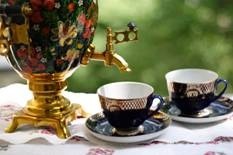Russian interest in tea began in the 1600’s when tea was presented as gifts to Russian officials including the Tsar. Then when a common border was established between Russia and China, Russian caravans would arrive laden with furs to exchange with traders and tea was brought back from China. This was a part of the famous Silk Road and was given the name of “Great Tea Road”. The trip was 11,000 miles long and took over 16 months – no wonder the tea had a smoky flavor after all those campfires!! Tea was so costly that although over six thousand camel loads of tea arrived annually, only the aristocrats could afford to buy it at first. By the late 1700.s however, the price had dropped some and tea was spreading throughout Russian society. Tea was ideally suited to Russian life – hearty, warm and sustaining. As the caravans gave way to the railway and transportation times were reduced, tea costs were lowered again and its popularity continued to rise. By the 19th century, Russia was second only to England in per capita tea consumption.
In an attempt to make the Soviet Union a self-sufficient tea producer, plantations were started in southern regions like Georgia, located in the Caucasus range on the shore of the Black Sea, but they never became popular. Georgia tea was reputed to be a tea of last resort but was a pleasant, full-bodied tea with flowery overtones. Since the fall of the Soviet Union, Georgian tea estates have all but disappeared. Indian and Ceylon black teas are preferred with additions such as honey, which is very healthy and very Russian, raspberry jam, which changes the taste dramatically, vodka and lemon. They have also been known to sip their tea through a sugar cube held between the teeth.
The Russian process of tea-making is two stages – first you make the tea concentrate, “zavarka” and then water it down with hot, boiled water, “kipyatok”. The concentrate is made in a teapot, “chainik”, made of ceramic or glass. The inside should be hot when the leaves are added, then closed to warm the leaves, then finally the hot, boiled water is added and when all the leaves sink, its ready! The teapot is traditionally kept warm with the skirt of a special doll called a “baba”. Finally, some of the concentrate is poured into a teacup or glasses with a stainless steel or brass holder, “podstakannik”, and diluted with additional hot, boiled water in the ratio of 10:1. They use a samovar, a large container resembling an ancient Greek vase, for the water boiling, steaming and boiled water portioning and it is central to the process of tea-making as well as a hallmark of the Russian way of life and hospitality
TEA TIME TIDBITS
A dirty trick of primarily state-operated enterprises
in Russia was to add baking soda to the tea.
It makes almost no difference in taste,
but the tea will look much stronger than it is.
“Taste and see that the Lord is good;
blessed is the man who takes refuge in him.”
Psalm 34:8

![logo_thumb[15] logo_thumb[15]](http://lh5.ggpht.com/-KmUVWPgwJe0/UjKUy97LfPI/AAAAAAAAKDc/QFV4glQ2g4g/logo_thumb%25255B15%25255D_thumb%25255B1%25255D.jpg?imgmax=800)
No comments:
Post a Comment